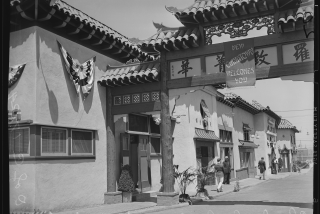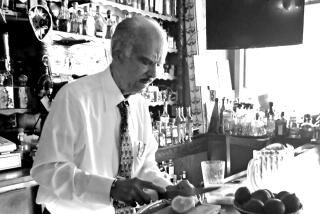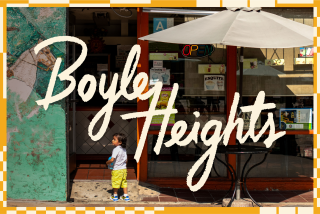At 90, He’s Still Making the Cut as a Barber in Chinatown
At first, Remigio Tapia seemed to roll with the ranks in the march of time.
In the Depression, the Mexican American lived in migrant camps picking cotton with Dust Bowl refugees in the San Joaquin Valley. Just before World War II, he hung out with the so-called pachucos in Boyle Heights. And in the war, he threw grenades into the hatches of German tanks in the Battle of the Bulge.
But once he opened his storefront barbershop in Chinatown, Tapia settled into a routine that has changed little over the years.
The frail man in the Irish tweed hat turns 90 today and, aside from moving a little slower, he spends his days as he has for 53 years, cutting hair and reading the newspaper in his favorite antique cherry-red barber chair.
“I don’t want to stay home and do nothing,” he said Saturday, his remarks punctuating the hum of the air conditioner and the slow snip of his assistant’s scissors. “I would be bored to death.”
During the week, Tapia works alone. On Saturdays he comes in to supervise his assistant, Angel Collado, 73, who has worked there off and on since the ‘50s. Tapia takes the bus from the Eastside, opens up shop and serves about three customers a day, most of whom have been visiting him for decades and provide just enough income so his business breaks even.
“He picks his customers,” said his daughter Chris. “They knock, and if he doesn’t know them or they don’t look safe, he won’t let them in.”
*
Tapia--who speaks Spanish, English and Yiddish from his boyhood days in then-heavily Jewish Boyle Heights--doesn’t know much Chinese, but has always managed to communicate with his clientele.
Frank Jung, 75, first came to the New China Town Barber Shop in the late 1940s, when it doubled as a bookie joint where customers would gather around a black and white RCA Victor to watch the horse races.
Today, that television is still there, as is the same General Electric clock on the wall. On the counter is the ancient cash register that doesn’t have any keys higher than the denomination of $1. And standing on the hair-flecked brown linoleum are those vintage vinyl chairs--equipped with stainless steel ashtrays.
But Jung doesn’t stop by once a month for the ambience. “It’s a good haircut and I trust him,” he said, quipping, “If I said anything else, he’d cut my ear off.”
Though Tapia shaves his own face with a straight razor, he no longer puts the knife to other people’s throats.
Just haircuts and a shampoo, which take about half an hour and cost a combined $7.
For lunch, Tapia, who eats three meals a day, no longer cruises in his ’77 Oldsmobile over to Clifton’s Cafeteria as he did several years back. He doesn’t like the food as much, and, because of cramps in his leg, he is relegated to riding a bus. Now the former smoker strolls around Chinatown at lunch, without a cane, content with his independence and health.
“I don’t know what gives me life,” he said. “I do a little calisthenics in the morning.”
More to Read
Sign up for Essential California
The most important California stories and recommendations in your inbox every morning.
You may occasionally receive promotional content from the Los Angeles Times.











